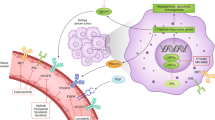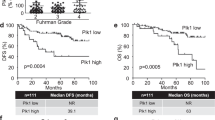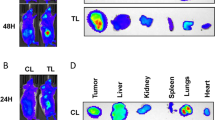Abstract
The von Hippel–Lindau tumor suppressor protein (pVHL) suppresses tumor formation by binding the α subunits of hypoxia-inducible factors (HIFs) responsible for stimulating tumor angiogenesis and glycolysis, targeting them for ubiquitination and proteasomal destruction. Loss of pVHL leads to the development of sporadic renal cell carcinomas (RCCs). In the present study, we sought to determine whether engineered overexpression of pVHL in tumors other than RCC can inhibit tumor growth, either as a monotherapy, or in combination with antisense HIF-1α therapy. Intratumoral injection of subcutaneous EL-4 thymic lymphomas with an expression plasmid encoding pVHL resulted in the downregulation of HIF-1α and vascular endothelial growth factor (VEGF). There was a concomitant reduction in tumor angiogenesis and increased tumor cell apoptosis due in part to downregulation of Bcl-2 expression. VHL therapy resulted in the complete regression of small (0.1 cm diameter) tumors whereas, in contrast, large (0.4 cm diameter) EL-4 tumors were only slowed in their growth. Nevertheless, large tumors completely regressed in response to intratumoral injection of a combination of antisense HIF-1α and VHL plasmids. Combination therapy resulted in increased losses of HIF-1α, VEGF, and tumor blood vessels, and increased tumor cell apoptosis. These novel results suggest that synergistic therapies that simultaneously block the expression or function of HIF-1α, and enhance the expression or function of VHL may be beneficial in the treatment of cancer.
This is a preview of subscription content, access via your institution
Access options
Subscribe to this journal
Receive 12 print issues and online access
$259.00 per year
only $21.58 per issue
Buy this article
- Purchase on Springer Link
- Instant access to full article PDF
Prices may be subject to local taxes which are calculated during checkout




Similar content being viewed by others
References
Kondo K, Kaelin WG . The von Hippel–Lindau tumor suppressor gene. Exp Cell Res 2001; 264: 117–125.
McKusick VA . Mendelian Inheritance in Man. Johns Hopkins University Press: Baltimore and London, 1992.
Krek W . VHL takes HIF's breath away. Nat Cell Biol 2000; 2: E1–E3.
Blancher C, Harris AL . The molecular basis of the hypoxia response pathway: tumor hypoxia as a therapy target. Cancer Metast Rev 1998; 17: 187–194.
Wang GL, Semenza GL . General involvement of hypoxia-inducible factor-1 in transcriptional response to hypoxia. Proc Natl Acad Sci USA 1993; 90: 4304–4308.
Wang GL, Jiang B-H, Rue EA, Semenza GL . Hypoxia-inducible factor 1 is a basic–helix–loop—helix–PAS heterodimer regulated by cellular O2 tension. Proc Natl Acad Sci USA 1995; 92: 5510–5514.
Liu LX et al. Stabilization of vascular endothelial growth factor mRNA by hypoxia-inducible factor 1. Biochem Biophys Res Commun 2002; 291: 908–914.
Ohh M et al. Ubiquitination of hypoxia-inducible factor requires direct binding to the beta-domain of the von Hippel–Lindau protein. Nat Cell Biol 2000; 2: 423–427.
Yu F, White SB, Zhao Q, Lee FS . HIF-1α binding to VHL is regulated by stimulus-sensitive proline hydroxylation. Proc Natl Acad Sci USA 2001; 98: 9630–9635.
Ivan M et al. HIFα targeted for VHL-mediated destruction by proline hydroxylation: implications for O2 sensing. Science 2001; 292: 464–468.
Jaakkola P et al. Targeting of HIF-1α to the von Hippel–Lindau ubiquitinylation complex by O2-regulated prolyl hydroxylation. Science 2001; 292: 468–472.
Lando D et al. Asparagine hydroxylation of the HIF transactivation domain: a hypoxic switch. Science 2002; 295: 858–861.
Dann CE, Bruick RK, Deisenhofer J . Structure of factor-inhibiting hypoxia-inducible factor 1: An asparaginyl hydroxylase involved in the hypoxic response pathway. Proc Natl Acad Sci USA 2002; 99: 15351–15356.
Jiang BH et al. Dimerization, DNA binding, and transactivation properties of hypoxia-inducible factor 1. J Biol Chem 1996; 271: 17771–17778.
Ratcliffe PJ et al. Oxygen sensing, hypoxia-inducible factor-1 and the regulation of mammalian gene expression. J Exp Biol 1998; 201: 1153–1162.
Semenza GL et al. Hypoxia response elements in the aldolase A, enolase 1, and lactate dehydrogenase A gene promoters contain essential binding sites for hypoxia-inducible factor 1. J Biol Chem 1996; 271: 32529–32537.
Dachs GU, Stratford IJ . The molecular response of mammalian cells to hypoxia and the potential for exploitation in cancer therapy. Br J Cancer 1996; 74: S126–132.
Iliopoulos O, Kibel A, Gray S, Kaelin WG . Tumor suppression by the human von Hippel–Lindau gene product. Nat Med 1995; 1: 822–826.
Sun X et al. Gene transfer of antisense hypoxia inducible factor-1α enhances the therapeutic efficacy of cancer immunotherapy. Gene Therapy 2001; 8: 638–645.
Jiang B-H, Agani F, Passaniti A, Semenza GL . V-src induces expression of hypoxia-inducible factor 1 (HIF-1) and transcription of genes encoding vascular endothelial growth factor and enolase 1: involvement of HIF-1 in tumor progression. Cancer Res 1997; 57: 5328–5335.
Feldser D et al. Reciprocal positive regulation of hypoxia-inducible factor 1α and insulin-like growth factor 2. Cancer Res 1999; 59: 3915–3918.
Kanwar JR et al. Vascular attack by 5,6-dimethylxanthenone-4-acetic acid combined with B7.1-mediated immunotherapy overcomes immune-resistance and leads to the eradication of large tumors. Cancer Res 2000; 61: 1948–1956.
Kanwar JR et al. Affect of survivin antagonists on the growth of established tumors and B7.1 immunogene therapy. J Natl Cancer Inst 2001; 93: 1541–1552.
Grimaite M, Werner-favre C, Kindler V, Zubler RH . Human naïve B cells cultured with EL-4 T cells mimic a germinal center-related B cell stage before generating plasma cells. Concordant changes in Bcl-2 protein and messenger RNA levels. Eur J Immunol 1997; 27: 199–205.
Reed JC . Double identity for proteins of the Bcl-2 family. Nature 1997; 387: 773–776.
Ponomarev ED, Tarasenko TN, Sapozhnikov AM . Splenic cytotoxic cells recognize surface HSP70 on culture-adapted EL-4 mouse lymphoma cells. Immunol Lett 2000; 74: 133–139.
Ohh M et al. The von Hippel–Lindau tumor suppressor protein is required for proper assembly of an extracellular fibronectin matrix. Mol Cell 1998; 1: 959–968.
Davidowitz EJ, Schoenfeld AR, Burk RD . VHL induces renal cell differentiation and growth arrest through integration of cell–cell and cell–extracellular matrix signaling. Mol Cell Biol 2001; 21: 865–874.
Lieubeau-Teillet B et al. Von Hippel–Lindau gene-mediated growth suppression and induction of differentiation in renal cell carcinoma cells grown as multicellular tumor spheroids. Cancer Res 1998; 58: 4957–4962.
Devarajan P et al. The von Hippel–Lindau gene product inhibits renal cell apoptosis via Bcl-2-dependent pathways. J Biol Chem 2001; 276: 40599–40605.
Datta K, Sundberg C, Karumanchi SA, Mukhopadhyay D . The 104–123 amino acid sequence of the beta-domain of von Hippel–Lindau gene product is sufficient to inhibit renal tumor growth and invasion. Cancer Res 2001; 61: 1768–1775.
Koochekpour S et al. The von Hippel–Lindau tumor suppressor gene inhibits hepatocyte growth factor/scatter factor-induced invasion and branching morphogenesis in renal carcinoma cells. Mol Cell Biol 1999; 19: 5902–5912.
Pioli PA, Rigby WFC . The von Hippel–Lindau protein interacts with heteronuclear ribonucleoprotein A2 and regulates its expression. J Biol Chem 2001; 276: 40346–40352.
Los M et al. Regulation of the urokinase-type plasminogen activator system by the von Hippel–Lindau tumor suppressor gene. Cancer Res 1999; 59: 4440–4445.
Jiang Y et al. Gene expression profiling of a renal cell carcinoma cell line: dissecting VHL and hypoxia-dependent pathways. Mol Cancer Res 2003; 6: 453–462.
Wykoff CC et al. Identification of novel hypoxia dependent and independent target genes of the von Hippel–Lindau (VHL) tumor suppressor by mRNA differential expression profiling. Oncogene 2000; 19: 6297–6305.
Gnarra JR et al. Post-transcriptional regulation of vascular endothelial growth factor mRNA by the product of the VHL tumor suppressor gene. Proc Natl Acad Sci USA 1996; 93: 10589–10594.
Mack FA et al. Loss of pVHL is sufficient to cause HIF dysregulation in primary cells but does not promote tumor growth. Cancer Cell 2003; 3: 75–88.
Kanwar JR, Berg RW, Lehnert K, Krissansen GW . Taking lessons from dendritic cells: multiple xenogeneic ligands for leukocyte integrins have the potential to stimulate anti-tumor immunity. Gene Therapy 1999; 6: 1835–1844.
Sun X et al. Mouse B7-H3 induces antitumor immunity. Gene Therapy 2003, in press.
Sun X et al. Angiostatin enhances B7.1-mediated cancer immunotherapy independently of affects on vascular endothelial growth factor expression. Cancer Gene Ther 2001; 8: 719–727.
Kayar SR, Archer PG, Lechher AJ, Banchero N . Evaluation of the concentric-circles method for estimating capillary-tissue diffusion distances. Microvasc Res 1982; 24: 342–353.
Maxwell PH et al. Hypoxia-inducible factor-1 modulates gene expression in solid tumors and influences both angiogenesis and tumor growth. Proc Natl Acad Sci USA 1997; 94: 8104–8109.
Acknowledgements
This work was supported in part by grants from The Wellcome Trust, the Royal Society of New Zealand, the Health Research Council of New Zealand, and the Maurice and Phyllis Paykel Trust. XS is a recipient of a Wellcome Trust Research Leave Fellowship.
Author information
Authors and Affiliations
Rights and permissions
About this article
Cite this article
Sun, X., Kanwar, J., Leung, E. et al. Regression of solid tumors by engineered overexpression of von Hippel–Lindau tumor suppressor protein and antisense hypoxia-inducible factor-1α. Gene Ther 10, 2081–2089 (2003). https://doi.org/10.1038/sj.gt.3302118
Received:
Accepted:
Published:
Issue Date:
DOI: https://doi.org/10.1038/sj.gt.3302118
Keywords
This article is cited by
-
Adenoviral delivery of VHL suppresses bone sarcoma cell growth through inhibition of Wnt/β-catenin signaling
Cancer Gene Therapy (2019)
-
The antiangiogenic activities of ethanolic crude extracts of four Salvia species
BMC Complementary and Alternative Medicine (2013)
-
Overexpression of von Hippel-Lindau tumor suppressor protein and antisense HIF-1α eradicates gliomas
Cancer Gene Therapy (2006)



